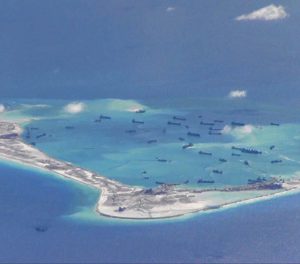OPINION: To achieve a peaceful solution in the South China Sea, the West must understand that Beijing’s motives are, in fact, driven by domestic politics
From our April 2016 edition – download the complete issue via our app here
US patrols have occurred sporadically in the South China Sea for decades, but they are attracting renewed attention now because of China’s island-building projects in the Spratly and Paracel islands. Since October, the US has twice carried out its stated intention to “fly, sail and operate wherever international law permits” by ignoring China’s territorial claims and passing within 20km of the country’s new artificial islands.

It is difficult to defend Beijing’s decision to assert itself in such an extreme and provocative manner. Its refusal to entertain meaningful dialogue on the issue is equally belligerent and disruptive to regional security. Yet the conversation cannot begin and end here. The reasons behind this situation are complex, with the roots of the problem extending beyond Beijing.
Perhaps most importantly, potential solutions that may reduce the chances of further hostilities are unlikely to be achieved from the reductive point of view that more typically prevails in the West.
Indeed, the presence of ‘rising’ China has only been felt by the US in particular relatively recently, with the former gradually filling the void left by the Soviet Union as a non-Western rival and potential threat from the mid-1990s. Partly as a result, Beijing’s actions and motives are often viewed ahistorically. China – particularly because of its nondemocratic status and its resulting problematic relationship with the so-called ‘international community’ – is depicted as expansionist and aggressive essentially because its newfound capabilities allow it to be so.
The problem with this view is that key considerations are lost. First, the US has never been encircled by foreign troops and bases as China has been for almost 70 years; the sensitivity and paranoia this can engender is rarely considered in the West. This is especially important when we recall the violence China suffered at the hands of others in the century beforehand, throughout its so-called ‘hundred years of humiliation’. It is also usually forgotten that China’s claims to the South China Sea originate with the Western-backed Kuomintang party in 1947.
Also useful to remember is Beijing’s intended audience. China’s artificial islands are not there simply to intimidate its neighbours, to send a message to the US or for the projection of power for power’s sake (although elements of each cannot be completely ignored). Rather, these would all be means to the greater end of securing public approval for the Chinese Communist Party and, therefore, its survival. This goal ultimately remains the principle motivator of its foreign policy and politics more broadly.
In an era when Beijing gains its domestic legitimacy primarily from reducing poverty and raising living standards, but when the national economy is slowing, it must increasingly appeal to nationalist sentiment: to the Chinese desire for their country to be respected abroad and for its sovereignty to be defended. It is no coincidence that President Xi Jinping’s ‘Chinese Dream’, launched in 2012, is laden with rhetoric of national glory.
None of this is to exonerate China from blame. It is simply to say that China’s historical and ongoing experiences with the wider world do much to inform its policies today, and that this is the basis from which solutions to the current South China Sea disputes should be drawn. Put another way, the problem is neither one-dimensional nor ahistorical, which means that its solution cannot be either.
This is where Asean comes in. For Asean, China is nothing new. This economic and geographical behemoth has always been a visible part of the landscape and integral to regional affairs, which helps to explain why local perceptions of rising China are mixed, with some trepidation and resistance but most cautiously welcoming the opportunities that China brings. Broadly speaking, maritime states with territorial claims in the South China Sea are more troubled by China’s recent incursions than Asean’s continental members; the Philippines has taken its territorial dispute with China to the Permanent Court of Arbitration in The Hague, and Vietnam, Brunei and Malaysia have overlapping claims. Simultaneously, there are concerns that the ‘pivot’ to Asia of a reactionary US could militarise the region and increase the likelihood of conflict.
However, the institution as a whole is keen to ensure that neither China nor the US establishes a position of dominance in regional affairs. It is crucial that Asean sustains this united front. China’s land reclamation project – while unjustified – must be recognised for what it primarily represents: an effort to sustain domestic legitimacy by defending a sovereignty that has been compromised so often in the past. The project is not about Chinese aggression per se, but more about Chinese self-consciousness and the need to restore respect. This is not an issue resolved by military action.
A strong Asean is a powerful force in Southeast Asia and one capable of engaging with China on terms that suit both parties. China may recently have acted with little regard for others, but this does not mean that peaceful resolutions are impossible. Beijing has negotiated before on regional claims, notably with Vietnam over the Gulf of Tonkin where the resulting agreements hold to this day.
A divided Asean in which some members gravitate toward the US in response to China’s actions, leaving others with difficult strategic choices, could mean that minor but existing internal faultlines break the institution from within. Worse, it could exacerbate Chinese paranoia and the belief that it is being contained. As China’s economy slows, Asean economies will likely be deemed more important by Beijing. This advantage can be seized by Asean – which has far greater strength united than the sum of its parts – and its quarrels with China are more likely to be resolved if a more nuanced understanding of its causes can prevail.
Oliver Turner is a Hallsworth fellow in political economy at the University of Manchester and an associate fellow at the Swedish Institute of International Affairs. He is also the author of the 2014 book, American Images of China: Identity, Power, Policy.
Keep reading:
“US military build up in the Philippines ups the ante in South China Sea” – A recent militarisation deal between Washington and Manila will have lasting implications for territorial disputes in the South China Sea


